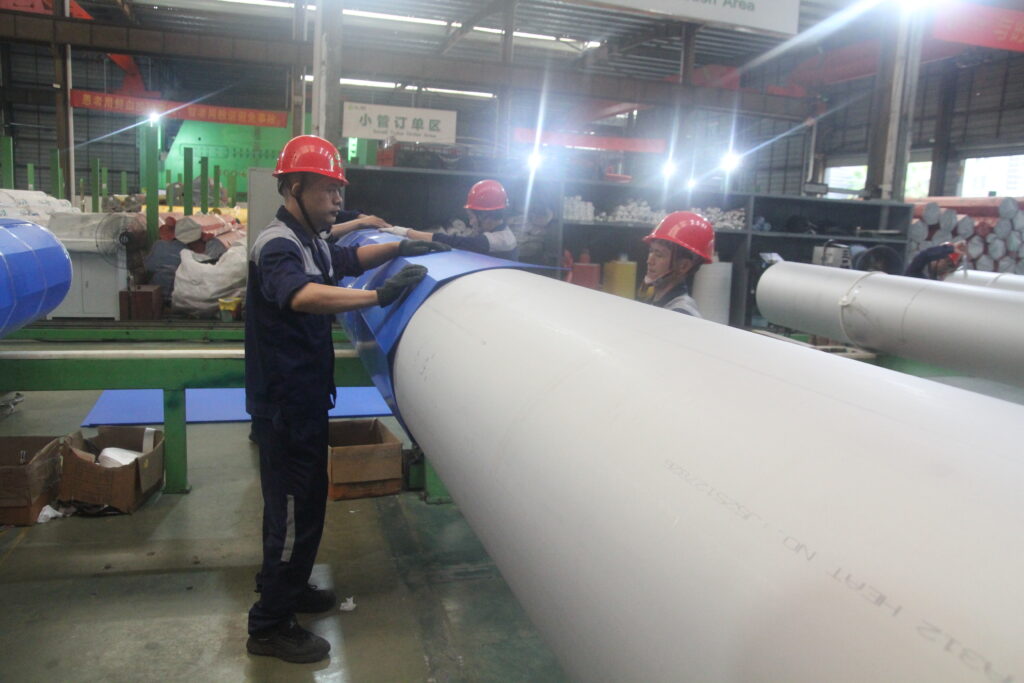How to Check Stainless Steel Pipe Inner Surface Roughness for Laboratory Systems
In laboratory gas delivery systems, stainless steel pipe inner surface roughness is one of the most important parameters affecting gas purity, sealing performance, and corrosion resistance. An improperly polished inner surface may cause gas contamination or unstable flow. Therefore, verifying whether the inner surface roughness meets laboratory standards (typically Ra ≤ 0.8 μm) is essential for system reliability and safety.
At Ganyeah Group, we apply advanced polishing and testing techniques to ensure every pipe meets the strictest cleanliness and smoothness requirements for laboratory and high-purity applications.

stainless steel pipes manufactured by Ganyeah Group
1. Step One: Review Certification and Roughness Reports
The first step in assessing stainless steel pipe inner surface roughness is verifying documentation provided by the supplier. Reliable manufacturers should offer standardized inspection data supported by accredited laboratories.
Key points to confirm:
- Certified Roughness Report:
Ask for a detailed Surface Roughness Inspection Report with CMA or CNAS marks. Ganyeah Group’s reports follow GB/T 3505-2009 and ISO 4287:1997, ensuring traceable and repeatable test results. - Ra Value Compliance:
Check that Ra ≤ 0.8 μm for high-purity gases or ≤ 1.6 μm for inert gas lines. Confirm that measurements were taken from the inner wall, not the outer surface. - Sampling and Method:
Ensure multiple samples were tested (e.g., one per 10 pipes). This minimizes deviation and ensures batch consistency for laboratory-grade stainless steel pipes.
2. Step Two: Visual and Tactile Inspection of the Pipe Interior
After receiving the materials, conduct a quick on-site evaluation of stainless steel pipe inner surface roughness before laboratory testing.
Visual Check:
- A qualified pipe shows a bright, uniform mirror-like surface.
- Unqualified pipes appear dull or contain visible weld marks and oxide layers.
Use a flashlight or endoscope to inspect the middle section, since polishing at pipe ends can sometimes be misleading.
Tactile Check:
Run your gloved fingers along the inner surface. A properly treated pipe feels smooth and consistent; noticeable resistance or debris indicates insufficient polishing.
At Ganyeah Group, each welded stainless steel pipe is TIG-welded and mechanically polished to maintain consistent inner roughness throughout its length.
<h33. Step Three: Instrumental Measurement for Accurate Ra Values
For precise verification of stainless steel pipe inner surface roughness, two types of instruments are commonly used in laboratory environments:
(1) Contact-Type Surface Roughness Tester
- Principle: A diamond probe measures microscopic height deviations along the pipe surface.
- Accuracy: ±0.02 μm, suitable for verifying Ra ≤ 0.8 μm.
- Usage: Clean the inner wall with ethanol before testing; measure along both the axial and circumferential directions.
(2) Non-Contact Laser Roughness Tester
- Principle: Laser reflection maps the microtopography of the surface.
- Advantages: Ideal for curved, bent, or thin-walled pipes.
- Accuracy: ±0.05 μm, sufficient for confirming Ra ≤ 1.0 μm in lab-grade systems.
Ganyeah Group employs both methods to ensure full compliance with high-purity gas pipeline standards and accurate measurement of stainless steel pipe inner surface roughness.
4. Common Errors in Evaluating Surface Roughness
- Focusing Only on Outer Surface:
Laboratory performance depends on inner surface roughness, not outer polish. - Over-Polishing Misconception:
Ra values below 0.3 μm add unnecessary cost without improving performance in most lab systems. - Skipping Post-Test Cleaning:
Always clean pipes with pure nitrogen or alcohol after roughness testing to remove residue.
5. Verification Summary for Laboratory Systems
| Step | Verification Method | Purpose | Reference |
|---|---|---|---|
| 1 | Review reports & certificates | Confirm Ra ≤ 0.8 μm | GB/T 3505 / ISO 4287 |
| 2 | Visual & tactile inspection | Identify surface defects | Pre-installation stage |
| 3 | Instrumental measurement | Quantify roughness accurately | Laboratory validation |
Ganyeah Group’s strict stainless steel pipe inner surface roughness control ensures consistent gas purity, corrosion resistance, and long service life in laboratory, semiconductor, and chemical research systems.
Ensuring proper stainless steel pipe inner surface roughness is not only about achieving a mirror finish—it is about controlling microscopic smoothness to maintain gas purity and corrosion resistance.
By combining professional testing, precision polishing, and quality assurance, Ganyeah Group delivers stainless steel pipes that meet the most demanding laboratory standards worldwide. Whether for high-purity gases, cleanroom pipelines, or analytical systems, Ganyeah Group guarantees precision you can rely on.
